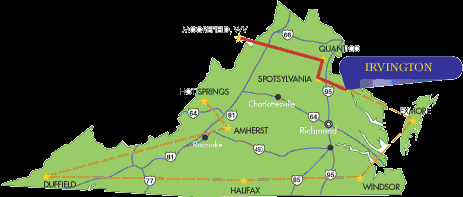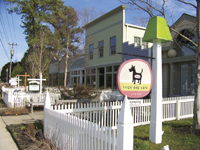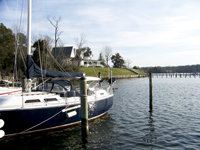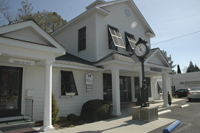Download
in PDF Format
Hip, chic, quiet and
quaint all describe this Northern Neck village.
Dreaming of the perfect
getaway? Someplace with hip restaurants in a sophisticated waterfront
resort town full of chic shops, top-notch golf courses, a resort enjoyed
by presidents, and an inn frequented by celebrities?
|

The
trendy Trick Dog Cafe is located among chic shops and eateries in
the heart of Irvington. |
Or do you prefer the
quiet, casual lifestyle of a quaint historic village tucked away on a
picturesque creek where patriotic pride can be seen on its flag-lined
streets, and a town commons serves as the gathering place for outdoor
markets, concerts, parades and holiday fun?
The historic
village
of
Irvington
on Carters Creek is all this and much more.
Located in
Lancaster
County
at the tip of the Northern Neck, everything in the village is within
walking distance. There are no stoplights, people take time to talk, and
family histories run deep. And despite its close proximity to metropolitan
areas � less than a three-hour drive to Washington, D.C., one hour to
Richmond, and a quick boat ride up the Rappahannock River from the
Chesapeake Bay � Irvington remains a hidden treasure.
|

The
view from the Tides Inn Conference Center could be a distraction
for even the most dedicated business excecutive. |
The natural beauty of the
waterways has always lured people to its shores. Powhatan Indians were
among the first to fish the rivers and in 1608, Captain John Smith
explored the backwaters. In the 1700s, the wealthy and powerful
colonialist, Robert �King� Carter, settled the land around the creek
that bears his name.
From its earliest
settlement days, residents found resourceful ways to take advantage of the
creek. Besides offering a rich resource for fishing, crabbing and
oystering, the many inlets and coves served as boulevards for water
vehicles � six miles by land to Weems but only two miles by boat.
Watercraft transported people to church or to visit neighbors while
ferries and barges carried workers and horses from shore to shore.
With the advent of the
steamboat era in the 19th century, vacationers along the eastern seaboard
discovered a lively destination that offered luxurious resort and
beachfront accommodations. Conven�iently situated between the
international commerce centers of
Baltimore
and
Norfolk
,
Irvington
�s wharf served as the southern entry to the county and the town soon
became the center of commercial, social and cultural life in
Lancaster
.
Irvington
�s business district included the offices of the state�s largest
newspaper of the time, the weekly Virginia Citizen. There was an ice cream
parlor; roller-skating rink; shirt, bottling, canning and fish factories;
and even an opera house capable of accommodating 90 players on stage at
once.
But commercial prosperity
began to fade after a devastating fire razed the business district in
1917. At the time, the town was depleted of men due to the fishing season
and World War I, leaving mostly women to heroically save what they could
as the fire spread from building to building.
After the war, the hoopla
of the steamboat era returned bigger than ever. According to newspaper
accounts, by 1930 the town�s Independence Day celebrations drew nearly
5,000 revelers with people cramming aboard anything that would float to
watch the boat races and crowning of Miss Rappahannock aboard a barge. An
all-day food fest accompanied afternoon baseball playoffs and a track meet
while planes gave the daring few a flight over the bay. Festivities
culminated that evening with an original production at the opera house.
But the turbulent �30s
had devastating effects on the area. In the middle of the Depression, the
great storm of 1933 took out 18 of the steamboat industry�s 30 wharfs,
marking the end of the industry. The automobile shifted transportation to
land and the area became isolated by the very waters that had brought so
much glory its way. The golden days were over.
Today,
Irvington
is the perfect destination for those looking for a slow, relaxed pace.
|

Whether
you arrive by private yacht or just want to try your hand at
boating for the day, you'll find plenty of opportunities to tour
the river when you visit Irvington. |
Walk along streets named
Steamboat Lane
,
Tavern Road
and
King Carter Drive
and it feels as though not much has changed since the heyday of
steamboats. Turn-of-the-century charm is evident in an abundance of
Victorian homes that dot the shores of the creek and village streets.
Look down to the old town
wharf and it is easy to picture a steamboat dropping off passengers from
Baltimore or imagine a river showboat bringing entertainment right up to
the dock.
�In 1915, my parents
took me aboard Capt. Jim Adams� Floating Theatre at
Irvington
wharf to see the play The Sweetest Girl in Dixie,� says Brainard
Edmonds, 94, a resident of
Lan�caster
County
. He remembers that Edna Ferber researched her book Show Boat on board the
theatrical barge, one of the last in operation on American rivers at that
time. Indeed, a check of Ferber�s research logs reveals that she spent a
week with the theater group in 1926, eating, playing, working, rehearsing,
and even taking her turn at selling tickets at the box-office window.
A tribute to the immense
importance of the steamboat industry to the area is the
Steamboat
Era
Museum
. Located adjacent to the town commons, the museum depicts the golden days
of steamboats through a collection of artifacts and exhibits that also
includes the role the Chesapeake Bay played in the Civil War.
�
Irvington
�s heyday was during the steamboat era, between 1890 and 1930,� says
Alexander McD. Fleet, the town�s mayor. And he should know. His
family�s roots go back to 1621 when Henry Fleete made the voyage from
England
to the colonies. While Capt. Fleete is credited with negotiating the
settlement of
Virginia
and
Maryland
with the Indians, he chose to settle near
Irvington
on
Fleets
Bay
.
Proud of his heritage as
one of
Irvington
�s founding families, any hint of a patriotic occasion and Mayor Fleet
orders the flying of the stars and stripes from street posts across town.
And come July 4th the place is alive with down-home patriotism, from a
hometown parade to a summer concert featuring the Air Force band. Bring a
picnic basket or dine on hot dogs courtesy of the local bank. Be sure to
stay for the Tides Inn�s spectacular fireworks display over the creek.
By mid-summer
Irvington
is decked out in crape myrtle trees dripping with blooms. Church bells
chime the hour and fill the air with hymns. Don�t be surprised to see a
bald eagle or some other feathered friend soaring gracefully overhead.
They are welcome visitors from one of the nearby bird sanctuaries.
|

Resident
George Lidicker gets lunch to-go at the popular coffee spot, The
Local. |
First Saturdays, the
farmers� market comes to the commons. Opening at a respectable 9 a.m.,
late for farmers but perfect for visitors, artisans offer hand-crafted
pottery, jewelry, clothes, and folk art for home and garden. It�s the
place to find flowers, native plants, homemade food and sweets, local
honey, goat cheese and a variety of area vegetables. From a library
book-swap to adoption of homeless pets, there�s something for everyone
at this popular event.
Across the lane,
vine-covered arches create a gateway into the whimsical and romantic world
of the Hope and Glory Inn. Considered one of the world�s top inns by
both Tatler Cunard and Conde Naste-Johansen, the inn was recently named a
top-10 American inn by USA Today.
The inn was the 1890
boarding school
of
Chesapeake
Academy and had twin front doors � one for boys and one for girls � in
keeping with a rule forbidding contact between the sexes. Proprietors
Peggy and Dudley Patteson retained the charming doors but tossed out the
rule in favor of a setting that encourages romantic interludes � a
courtyard fountain and balconied fa�ade framed by country gardens of
lavender wisteria, heirloom roses and hollyhocks spilling through white
picket fences. A garden path sprinkled with Victorian birdhouses and
garden art winds through guest cottages out back and into a private
outdoor shower and tub for bathing under the stars. Sophistication and
shabby chic combine in the inn�s interior d�cor of antiques and local
folk art. Don�t be surprised to bump into a celebrity guest or two.
Whimsy continues through
town in a cluster of shops that feature fashion boutiques, tourist shops,
and a trendy coffee house that is a favorite hangout of locals called,
well, The Local. Kooky art and fanciful kitsch sculptures dot the village
landscape � the front porch of Dr. Robert Westbrook�s dentist office
sports giant toothbrushes for columns and across the street a dog bone is
shingled onto the roof of the Trick Dog Caf�.
The quirky, chic eatery
got its name from a dog statue that was found in the ashes of the 1917
fire. The �dog� became known as a trick dog for its natural ability to
sit and stay. The Caf� picked up the bone, so instead of being �open�
or �closed,� they are �sleeping� or �playing� and customers
are invited to �sit and stay.� Proprietor Rob McRaney�s hip martini
bar and So-Ho cuisine give this place plenty to bark about.
Outrageously massive
corkscrews flanking the entrance to White Fences Vineyard and Winery on
the north end of town make it hard to miss. Uncork a bottle of chardonnay
in the tasting room with growers Phoebe and Mark Hollingsworth and sit
back and watch the grapes ripen on the vine. Or drive through to the
Tents, a compound loosely patterned after a �tent community� of
19th-century Methodist revivalist meetings in nearby Wharton�s Grove.
The distinctive Victorian/Gothic cottages offer a vacation alternative for
groups looking for a little seclusion and are available through the Hope
and Glory Inn. The preacher�s pulpit has been replaced with a swimming
pool and the closest thing to a baptism is the vineyard�s grape-stomping
harvest festival in September.
The luxurious yet casual
Tides Inn is situated on the dividing peninsula of the creek and offers
spectacular views of the water in a beautifully landscaped setting. Sedona
Resort Properties recently purchased the 1940s establishment from one of
Irvington
�s founding families, the Stephenses, and breathed new life and $12
million into renovations. The resort is listed in Zagat�s list of top-50
small resorts in the world and the 2007 winner of AAA�s 4-Diamond Award.
|

The
Irvington Center offers state-of-the-art technology services to
resident businesses including Select Properties Real Estate, the
legal offices of Spots and Fain, Bay Home Builders, Hock Financial
Group, architect John Paul Hanbury and technology software company
ConSepts, Inc. |
Dark mahogany plantation
shutters and ceiling fans evoke the casual style of British Colonial days
luring
U.S.
presidents out of D.C. to enjoy the inn�s conference facilities and golf
course. You don�t have to be a guest to take advantage of the spa or one
of four dining choices � try a romantic dinner cruise aboard the inn�s
yacht, the 127-foot Miss Ann. Launched in 1926, the ship�s colorful
history includes popular Whiskey Runs down the Rappahannock River � a
tradition that continues despite a change in state liquor laws in the
�70s.
Of course, the rivers and
creeks continue to be the biggest draw to the area. Sailboats and cruisers
have replaced steamboats while some people prefer to navigate Carters
Creek by kayak, keeping an eye out for osprey and blue heron. The creek
provides a picturesque view of the neighborhood for kayakers paddling in
and out of coves past gentle hills dotted with a mix of houses from summer
cottages to pricey estates.
Irvington
cherishes an atmosphere of remote tranquility. From a humble settlement of
160 inhabitants in 1860 to 673 residents today, it clings to a desire to
preserve the rural village that is both sophistication and down-home
living on the shores of Carters Creek.